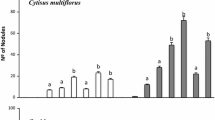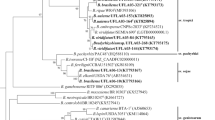Abstract
The competitiveness of dual-strain inoculum ofBradyrhizobium strains S24 and GR4 was demonstrated for nodulation of green gram (Vigna radiata). Strain S24 formed pink nodules, GR4 produced visually distinguishable dark-brown nodules. When a mixture of theseBradyrhizobium strains was applied as inoculum, nodules of both pink and dark-brown types were formed on the same root. The strain GR4, which was less competitive than strain S24, was mutagenized withN-methyl-N′-nitro-N-nitrosoguanidine to obtain pigment-diverse mutants and six selected mutants were screened for symbiotic parameters. One mutant produced pink nodules and appreciably increased plant dry mass. The competitive ability of this mutant lacking brown pigment was compared with that of strain S24 by using antibiotic resistance markers; it showed increased nodulation competitiveness than its parent strain GR4. The dark-brown nodule-phenotype could be useful in evaluating nodulation competitiveness of “cowpea miscellany” bradyrhizobia in soil where dark-brown nodule-forming strains are not indigenous.
Similar content being viewed by others
References
Amarger N., Lobreau J.P.: Quantitative study of nodulation competitiveness inRhizobium strains.Appl.Environ.Microbiol. 44, 583–588 (1982).
Bhagwat A.A., Tully R.E., Keister D.L.: Isolation and characterization of a competition-defectiveBradyrhizobium japonicum mutant.Appl.Environ.Microbiol. 57, 3496–3501 (1991).
Bohlool B.B., Schmidt E.L.: Non-specific staining: its control in immunofluorescence examination of soil.Science 162, 1012–1014 (1968).
Caradus J.R., Silvester W.B.:Rhizobium specific anthocyanin-like marker in lupin nodules.Plant & Soil 51, 437–440 (1979).
Chueire L.M.O., Hungria M.: N2-fixation ability of Brazilian soybean cultivars withSinorhizobium fredii andSinorhizobium xinjiangensis.Plant & Soil 196, 1–5 (1997).
Cunningham S.D., Kollmeyer W.D., Stacey G.: Chemical control of interstrain competition for soybean nodulation byBradyrhizobium japonicum.Appl.Environ.Microbiol. 57, 1886–1892 (1991).
Dadarwal K.R., Grover R., Tauro P.: Uptake hydrogenase inRhizobium and nodule leghemoglobin in cowpea miscellany hosts.Arch.Microbiol. 133, 303–306 (1982).
Dadakwal K.R., Sindhu S.S., Renu Batra: Ecology ofHap + Rhizobium strains of cowpea miscellany: native frequency and competence.Arch.Microbiol. 141, 255–259 (1985).
Dadarwal K.R., Sindhu S.S., Garg R.P.: Effect of curing on genes controlling antibiotic resistance and symbiosis in cowpea miscellany rhizobia.Indian J.Microbiol. 27, 16–21 (1987).
Dowling D.N., Broughton W.J.: Competition for nodulation of legumes.Ann.Rev.Microbiol. 40, 131–157 (1986).
Eaglesham A.R.J., Ahmad M.H., Hassousia S., Goldman B.: Cowpea rhizobia producing dark nodules: use in competitive studies.Appl.Environ.Microbiol. 44, 611–618 (1982).
El Hassan G.A., Hernandez B.S., Focht D.D.: Comparison Hup trait and intrinsic antibiotic resistance for assessing rhizobial competitiveness axenically and in soil.Appl.Environ.Microbiol. 51, 546–551 (1986).
Ellis W.R., Ham G.E., Schmidt E.L.: Persistence and recovery ofRhizobium japonicum in a field soil.Agronom.J. 76, 573–576 (1984).
Gibson A.H.: Physical, environmental and symbiotic nitrogen fixation — II. Root temperature effects on the relative nitrogen assimilation rates.Austral.J.Biol.Sci. 18, 295–299 (1965).
Goel A.K., Sindhu S.S., Dadarwal K.R.: Bacteriocin producing rhizobia of green gram (Vigna radiata L.Wilczek) having competitive advantage in nodulation.Microbiol.Res. 154, 43–48 (1999).
Halverson L.J., Stacey G.: Host recognition in theRhizobium-soybean symbiosis.Plant Physiol. 77, 621–625 (1985).
Johnston A.W.B., Hombrecher G., Brewin N.J., Cooper M.C.: Two transmissible plasmids inRhizobium leguminosarum strain 300.J.Gen.Microbiol. 128, 85–93 (1982).
Kremer R.J., Peterson H.L.: Nodulation efficiency of legume inoculation as determined by intrinsic antibiotic resistance.Appl.Environ.Microbiol. 43, 636–642 (1982).
Lambert G.R., Cantrell M.A., Hanus F.J., Russell S.A., Hadded K.R., Evans H.J.: Intra and inter species transfer and expression ofRhizobium japonicum hydrogen uptake genes and autotrophic growth capability.Proc.Nat.Acad.Sci.USA 82, 3232–3236 (1985).
Ouf S.A., Abdel-Hady N.F.: Influence of He-Ne laser irradiation of soybean seeds on seed mycoflora, growth, nodulation, and resistance toFusarium solani.Folia Microbiol. 44, 388–396 (1999).
Raffique-Uddin M., McLaughlin W., Ahmad M.H.: Competition between inoculum and native rhizobia for nodulation of cowpea (Vigna unguiculata (L.)Walp): use of a dark-nodule strain.Plant & Soil 81, 305–307 (1984).
Saini I., Sindhu S.S., Dadarwal K.R.: Azide-resistant mutants ofAzorhizobium caulinodans with enhanced symbiotic effectiveness.Folia Microbiol. 46, 217–222 (2001).
Sanjuan J., Olivares J.: Multicopy plasmids carrying theKlebsiella pneumoniae nifA gene enhanceRhizobium meliloti nodulation competitiveness on alfalfa.Mol.Plant-Microbe Interact. 4, 365–369 (1991).
Schwinghamer E.A.: Antagonism between strains ofRhizobium trifolii in culture.Soil Biol.Biochem. 3, 355–363 (1971).
Sharma P.K., Anand R.C., Lakshminaryana K.: Construction of Tn5 tagged mutants ofRhizobium spp. (Cicer) for ecological studies.Soil Biol.Biochem. 23, 881–885 (1991).
Sharma P.K., Upadhyay K.K., Kamboj D.K., Kukreja K.: Preincubation ofMesorhizobium ciceri with flavonoids improves its nodule occupancy.Folia Microbiol. 47, 541–544 (2002).
Sindhu S.S., Dadarwal K.R.: Hydrogen uptake-measurement of photosynthetic limitation in nodules of cowpea miscellany hosts.Microbiol.Res. 150, 213–217 (1995).
Sindhu S.S., Dadarwal K.R.: Competition for nodulation among rhizobia in legumeRhizobium symbiosis.Indian J.Microbiol. 40, 211–246 (2000).
Sindhu S.S., Dadarwal K.R.: Symbiotic effectiveness of spontaneous antibiotic-resistant mutants ofRhizobium sp.Cicer nodulating chickpea (Cicer arietinum).Microbiol.Res. 155, 325–329 (2001).
Sindhu S.S., Gupta S.K., Dadarwal K.R.: Antagonistic effect ofPseudomonas spp. on pathogenic fungi and enhancement of plant growth in green gram (Vigna radiata).Biol.Fertil.Soils 29, 62–68 (1999).
Sloger C.: Symbiotic effectiveness and N2 fixation in nodulated soybean.Plant Physiol. 44, 1666–1668 (1969).
Somasegaran P., Hoben H.J.: Analyzing nodule occupancy using antibiotic resistant markers, pp. 153–157 inHandbook for Rhizobia: Methods in Legume-Rhizobium Technology. Springer-Verlag, New York 1994.
Triplett E.W.: The molecular genetics of nodulation competitiveness inRhizobium andBradyrhizobium.Mol.Plant-Microbe Interact. 3, 199–206 (1990).
Triplett E.W., Barta T.M.: Trifolitoxin production and nodulation are necessary for the expression of superior nodulation competitiveness byRhizobium leguminosarum bv.trifolii strain T24 on clover.Plant Physiol. 85, 335–342 (1987).
Triplett E.W., Sadowsky M.J.: Genetics of competition of nodulation for legumes.Ann.Rev.Microbiol. 46, 399–428 (1992).
Zablotowicz R.M., Focht D.D.: Physiological characteristics of cowpea rhizobia: evaluation of symbiotic efficiency inVigna unguiculata.Appl.Environ.Microbiol. 41, 679–685 (1981).
Zdor R.E., Pueppke S.G.: Early infection and competition for nodulation of soybean byBradyrhizobium japonicum 123 and 138.Appl.Environ.Microbiol. 54, 1996–2002 (1988).
Author information
Authors and Affiliations
Corresponding author
Rights and permissions
About this article
Cite this article
Sindhu, S.S., Sharma, H.R. & Dadarwal, K.R. Competition amongBradyrhizobium strains for nodulation of green gram (Vigna radiata): Use of dark-nodule strain. Folia Microbiol 48, 83–89 (2003). https://doi.org/10.1007/BF02931281
Received:
Revised:
Issue Date:
DOI: https://doi.org/10.1007/BF02931281




